BHEX Mini

BHEX Mini
Direct Imaging Black Holes from LEO
Ref Bari | 06/22 Update
















Antenna








Antenna
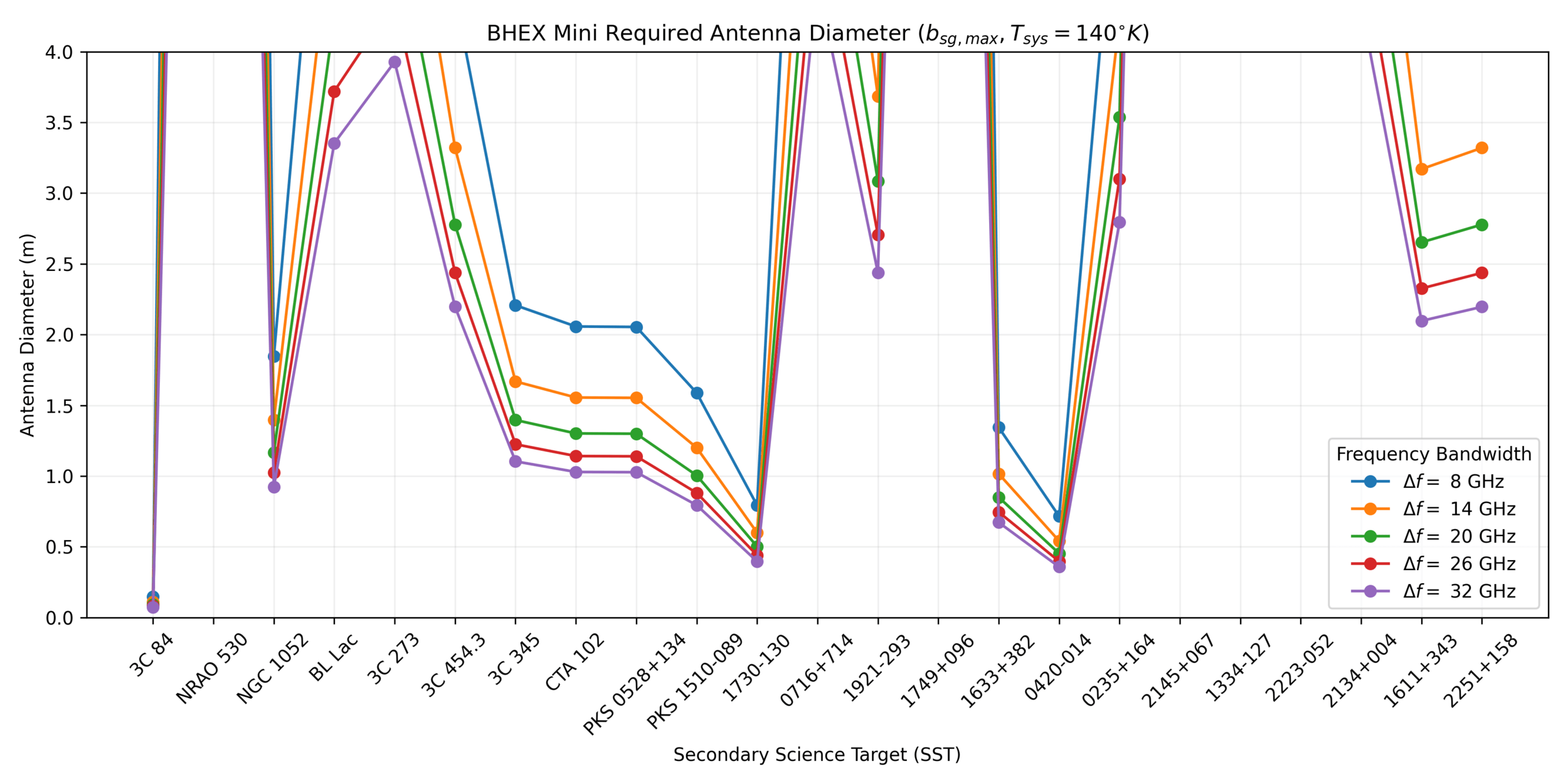








Receiver








Cryocooler








Solar Panels








Ultra-Stable Oscillator








Digital Backend








Downlink
Terminal



Original Analog Radio Signal



Sample the Signal every Unit Interval
Nyquist-Shannon Sampling Theorem



Retain only the samples and record the sign of the voltage for each sample


Reconstruct the original signal



Key Equations


Key Equations
Quantization Efficiency: how much of the analog SNR is retained after digitization


Key Equations
SNR: Signal to Noise Ratio


Key Equations
Data Generation Rate: In Bits per Second


Key Equations

Cross-Correlation
BHEX Mini Next Steps

Physics
Engineering
Funding
BHEX Mini Next Steps

Phy
- What are BHEX Mini's primary science objectives?
- To what extent can BHEX Mini achieve its objectives?
Eng
- SWaPC Requirements for Instrumentation
Fund
- Write Grant Proposals for Nelson Grants
- Write Abstract for SpaceCom 2026
- Write De-scoped BHEX Mini #1 & #2




Phy
- What are BHEX Mini's primary science objectives?
- To what extent can BHEX Mini achieve its objectives?
Eng
- SWaPC Requirements for Instrumentation
Fund
- Write Grant Proposals for Nelson Grants
- Write Abstract for SpaceCom 2026
- Write De-scoped BHEX Mini #1 & #2

Sub-milli arcsecond angular resolution:
Dual short and long baseline lengths:
Rapid coverage of (u,v) plane:


Decreased signal loss from LEO:
Decreased radiation environment in LEO vs. MEO

Phy
- What are BHEX Mini's primary science objectives?
- To what extent can BHEX Mini achieve its objectives?
- SWaPC Requirements for Instrumentation
- Write Grant Proposals for Nelson Grants
- Write Abstract for SpaceCom 2026
- Write De-scoped BHEX Mini #1 & #2

Sub-milli arcsecond angular resolution:
Dual short and long baseline lengths:
Rapid coverage of (u,v) plane:


Decreased signal loss from LEO:
Decreased radiation environment in LEO vs. MEO


- What kind of targets can we observe with this angular resolution?
Phy
- What are BHEX Mini's primary science objectives?
- To what extent can BHEX Mini achieve its objectives?

Sub-milli arcsecond angular resolution:
Dual short and long baseline lengths:




- What kind of targets can we observe with this angular resolution?
- SWaPC Requirements for Instrumentation
- Write Grant Proposals for Nelson Grants
- Write Abstract for SpaceCom 2026
- Write De-scoped BHEX Mini #1 & #2
Rapid coverage of (u,v) plane:
Decreased signal loss from LEO:
Decreased radiation environment in LEO vs. MEO
- What horizon-scale structure can we observe on long baselines?
- What extended structure can we probe on our shorter baseline?
Phy
- What are BHEX Mini's primary science objectives?
- To what extent can BHEX Mini achieve its objectives?

Sub-milli arcsecond angular resolution:
Dual short and long baseline lengths:

- What kind of targets can we observe with this angular resolution?
- SWaPC Requirements for Instrumentation
Rapid coverage of (u,v) plane:
- What horizon-scale structure can we observe on long baselines?
- What extended structure can we probe on our shorter baseline?
- What is the integration time for BHEX Mini on the (u,v) plane?
- Could that possibly enable direct imaging of dynamic accretion disk around Sgr A*? (i.e., creating a movie of a black hole!)
Fund
- Write Grant Proposals for Nelson Grants
- Write Abstract for SpaceCom 2026
- Write De-scoped BHEX Mini #1 & #2
Decreased signal loss from LEO:
Decreased radiation environment in LEO vs. MEO
Decreased radiation environment in LEO vs. MEO
Phy
- What are BHEX Mini's primary science objectives?
- To what extent can BHEX Mini achieve its objectives?


Rapid coverage of (u,v) plane:
- What is the integration time for BHEX Mini on the (u,v) plane?
- Could that possibly enable direct imaging of dynamic accretion disk around Sgr A*? (i.e., creating a movie of a black hole!)
Fund
- Write Grant Proposals for Nelson Grants
- Write Abstract for SpaceCom 2026
- Write De-scoped BHEX Mini #1 & #2
Decreased signal loss from LEO:
Decreased radiation environment in LEO vs. MEO
Decreased radiation environment in LEO vs. MEO
Phy
- What are BHEX Mini's primary science objectives?
- To what extent can BHEX Mini achieve its objectives?

Sub-milli arcsecond angular resolution:
Dual short and long baseline lengths:

- What kind of targets can we observe with this angular resolution?
- SWaPC Requirements for Instrumentation
Rapid coverage of (u,v) plane:
- What horizon-scale structure can we observe on long baselines?
- What extended structure can we probe on our shorter baseline?
- Can BHEX Mini enable imaging of dynamic accretion disk structure around Sgr A*?
Decreased signal loss from LEO:
- What is BHEX Mini's duty cycle? (i.e., how long will it be able to observe a radio target during one orbital period?)
- How much data will BHEX Mini collect over one orbit?
Decreased radiation environment in LEO vs. MEO
Phy
- What are BHEX Mini's primary science objectives?
- To what extent can BHEX Mini achieve its objectives?

Sub-milli arcsecond angular resolution:
Dual short and long baseline lengths:

- What kind of targets can we observe with this angular resolution?
- SWaPC Requirements for Instrumentation
Rapid coverage of (u,v) plane:
- What horizon-scale structure can we observe on long baselines?
- What extended structure can we probe on our shorter baseline?
Decreased signal loss from LEO:
- What is BHEX Mini's duty cycle? (i.e., how long will it be able to observe a radio target during one orbital period?)
- How much data will BHEX Mini collect over one orbit?
Decreased radiation environment in LEO vs. MEO
- How much less radiation (i.e., dosage per orbital period) will BHEX Mini in LEO have than BHEX in MEO?
- How much does that save us in mass? (i.e., because we don't have to radiation-harden our instrumentation)
- Can BHEX Mini enable imaging of dynamic accretion disk structure around Sgr A*?
Phy
- What are BHEX Mini's primary science objectives?
- To what extent can BHEX Mini achieve its objectives?


Challenges of Low-Earth Orbit at 86 GHz
- Virtually no ground station coverage due to high orbital velocity
- Cannot resolve Photon Ring at 86 GHz at LEO
- Space-Ground VLBI will be difficult due to atmospheric decoherence
- Interstellar medium scattering (ISM) is and significant for Sgr A*
- Prevents horizon-scale imaging for
- At 86 GHz, BHEX Mini has
Phy
- What are BHEX Mini's primary science objectives?
- To what extent can BHEX Mini achieve its objectives?


BHEX Mini Science Objectives (Safety)
- Supplement (u,v) coverage of Sgr A*/M87 at 86 GHz

BHEX Mini Science Objectives (Match)
- 86 GHz VLBI survey of AGN Targets with d~2.5m antenna
- Achieve Space-Space VLBI for the first time

BHEX Mini Science Objectives (Reach)
- Enable imaging of dynamical accretion disk phenomenon
- This would enable the first constraints on spin of Sgr A*
- Enable multi-messenger astronomy of binary black hole targets
- In conjunction with LIGO, LISA, or Einstein Telescope
Eng
- SWaPC Requirements for Instrumentation
Fund
- Write Grant Proposals for Nelson Grants
- Write Abstract for SpaceCom 2026
- Write De-scoped BHEX Mini #1 & #2



Phy
- What are BHEX Mini's primary science objectives?
- To what extent can BHEX Mini achieve its objectives?

Eng
- SWaPC Requirements for Instrumentation
Fund
- Write Grant Proposals for Nelson Grants
- Write Abstract for SpaceCom 2026
- Write De-scoped BHEX Mini #1 & #2



BHEX Mini Next Steps

Phy
- What are BHEX Mini's primary science objectives?
- To what extent can BHEX Mini achieve its objectives?

Eng
- SWaPC Requirements for Instrumentation
Fund
- Write Grant Proposals for Nelson Grants
- Write Abstract for SpaceCom 2026
- Write De-scoped BHEX Mini #1 & #2




Phy
- What are BHEX Mini's primary science objectives?
- To what extent can BHEX Mini achieve its objectives?

Eng
- SWaPC Requirements for Instrumentation
Fund
- Write Grant Proposals for Nelson Grants
- Write Abstract for SpaceCom 2026
- Write De-scoped BHEX Mini #1 & #2




Phy
- What are BHEX Mini's primary science objectives?
- To what extent can BHEX Mini achieve its objectives?

Eng
- SWaPC Requirements for Instrumentation
Fund
- Write Grant Proposals for Nelson Grants
- Write Abstract for SpaceCom 2026
- Write De-scoped BHEX Mini #1 & #2




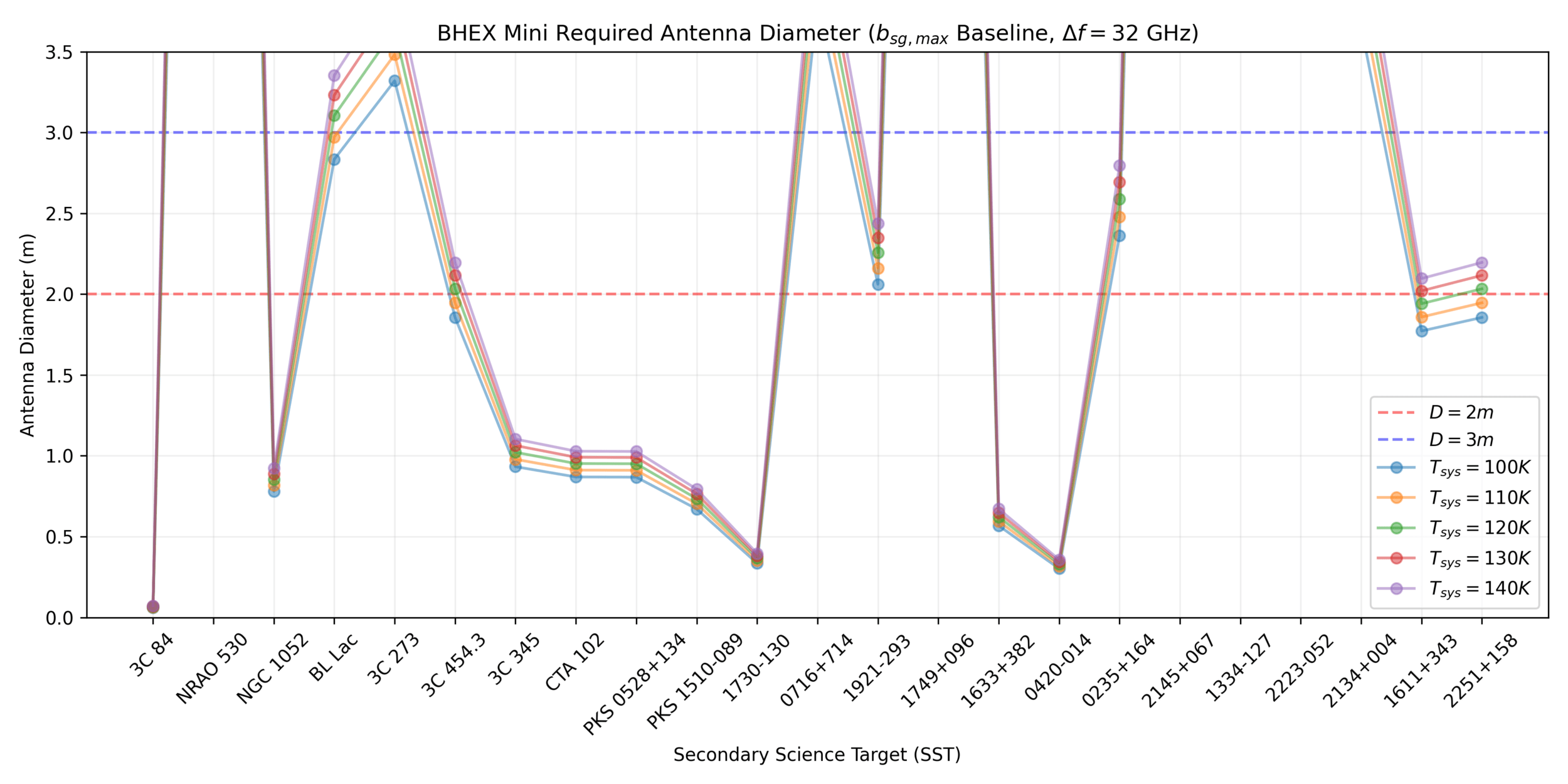
Phy
- What are BHEX Mini's primary science objectives?
- To what extent can BHEX Mini achieve its objectives?

Eng
- SWaPC Requirements for Instrumentation
Fund
- Write Grant Proposals for Nelson Grants
- Write Abstract for SpaceCom 2026
- Write De-scoped BHEX Mini #1 & #2





Phy
- What are BHEX Mini's primary science objectives?
- To what extent can BHEX Mini achieve its objectives?

Eng
- SWaPC Requirements for Instrumentation
Fund
- Write Grant Proposals for Nelson Grants
- Write Abstract for SpaceCom 2026
- Write De-scoped BHEX Mini #1 & #2




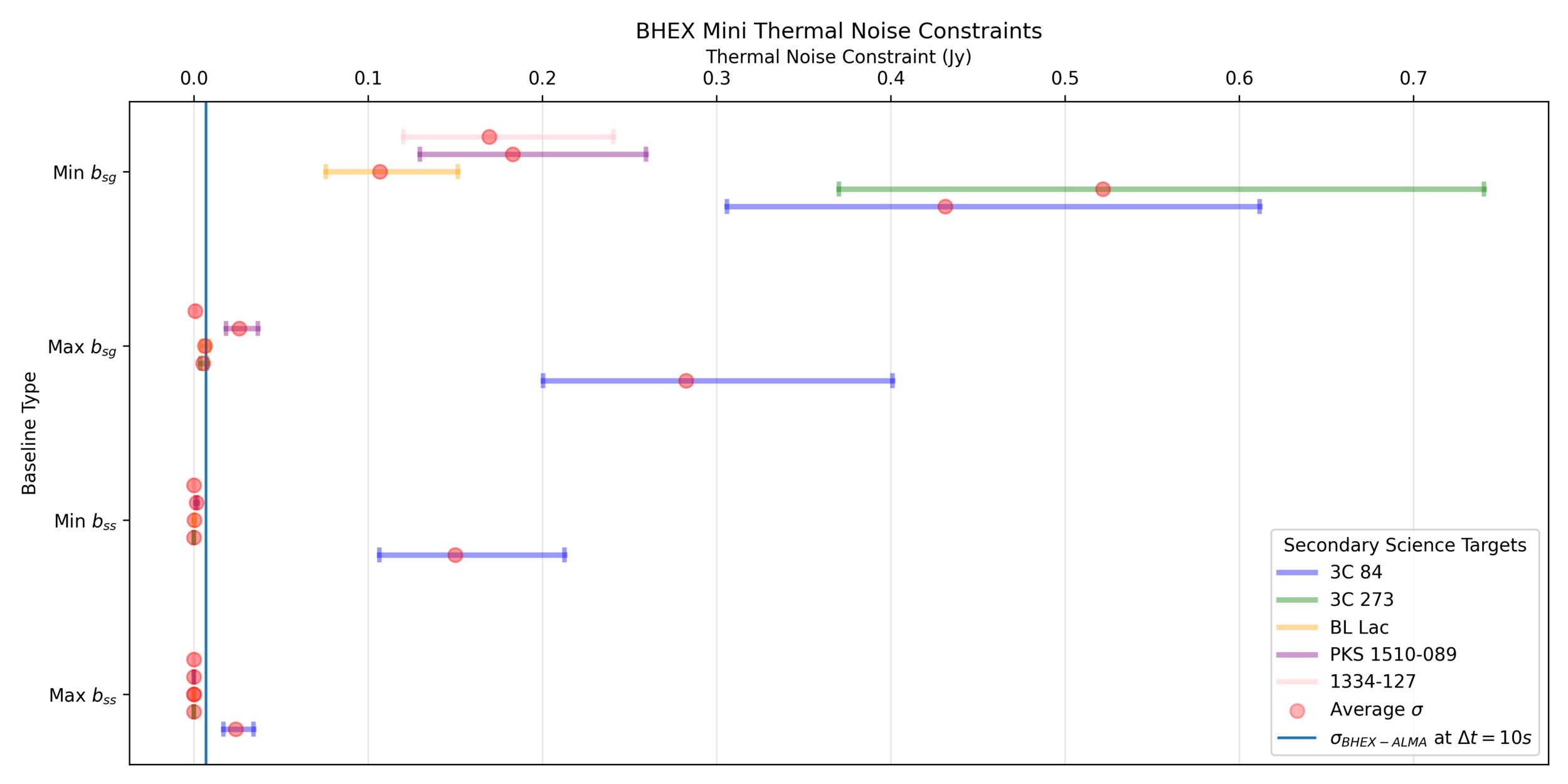
Phy
- What are BHEX Mini's primary science objectives?
- To what extent can BHEX Mini achieve its objectives?

Eng
- SWaPC Requirements for Instrumentation
Fund
- Write Grant Proposals for Nelson Grants
- Write Abstract for SpaceCom 2026
- Write De-scoped BHEX Mini #1 & #2





Phy
- What are BHEX Mini's primary science objectives?
- To what extent can BHEX Mini achieve its objectives?

Eng
- SWaPC Requirements for Instrumentation
Fund
- Write Grant Proposals for Nelson Grants
- Write Abstract for SpaceCom 2026
- Write De-scoped BHEX Mini #1 & #2













Phy
- What are BHEX Mini's primary science objectives?
- To what extent can BHEX Mini achieve its objectives?

Eng
- SWaPC Requirements for Instrumentation
Fund
- Write Grant Proposals for Nelson Grants
- Write Abstract for SpaceCom 2026
- Write De-scoped BHEX Mini #1 & #2




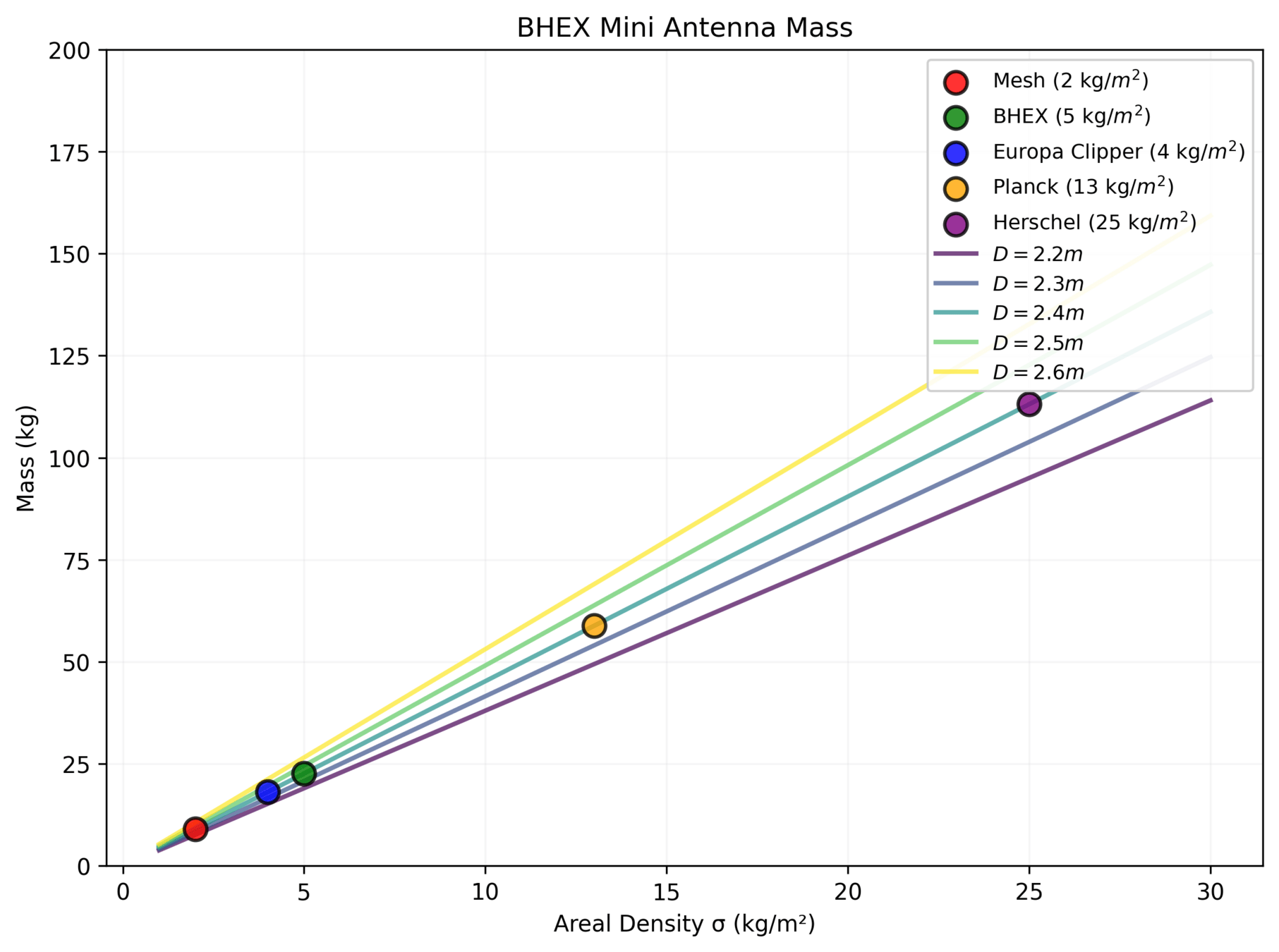
Phy
- What are BHEX Mini's primary science objectives?
- To what extent can BHEX Mini achieve its objectives?

Eng
- SWaPC Requirements for Instrumentation
Fund
- Write Grant Proposals for Nelson Grants
- Write Abstract for SpaceCom 2026
- Write De-scoped BHEX Mini #1 & #2





Phy
- What are BHEX Mini's primary science objectives?
- To what extent can BHEX Mini achieve its objectives?

Eng
- SWaPC Requirements for Instrumentation
Fund
- Write Grant Proposals for Nelson Grants
- Write Abstract for SpaceCom 2026
- Write De-scoped BHEX Mini #1 & #2





-
What material will we create the BHEX Mini antenna out of?
- This will determine the SWaPC requirements for the antenna
- What are state-of-the-art antenna designs with the least areal density?
-
Deployable vs. fixed antenna designs?
- Model surface accuracy of antenna
- Model aperture efficiency of antenna
- Phased array antenna design?
Phy
- What are BHEX Mini's primary science objectives?
- To what extent can BHEX Mini achieve its objectives?

Eng
- SWaPC Requirements for Instrumentation
Fund
- Write Grant Proposals for Nelson Grants
- Write Abstract for SpaceCom 2026
- Write De-scoped BHEX Mini #1 & #2




LT-RSP2 Cryocooler

Raytheon long life cryocoolers for future space missions (T. Conrad et. al., Cryogenics 2017)
Phy
- What are BHEX Mini's primary science objectives?
- To what extent can BHEX Mini achieve its objectives?

Eng
- SWaPC Requirements for Instrumentation
Fund
- Write Grant Proposals for Nelson Grants
- Write Abstract for SpaceCom 2026
- Write De-scoped BHEX Mini #1 & #2




Stirling Cryocooler
Development of Advanced Two-Stage Stirling Cryocooler for Next Space Missions (Y. Sato et. al., Cryocoolers 15, 2009)

Phy
- What are BHEX Mini's primary science objectives?
- To what extent can BHEX Mini achieve its objectives?

Eng
- SWaPC Requirements for Instrumentation
Fund
- Write Grant Proposals for Nelson Grants
- Write Abstract for SpaceCom 2026
- Write De-scoped BHEX Mini #1 & #2




Stirling Cryocooler
Development of Advanced Two-Stage Stirling Cryocooler for Next Space Missions (Y. Sato et. al., Cryocoolers 15, 2009)


Phy
- What are BHEX Mini's primary science objectives?
- To what extent can BHEX Mini achieve its objectives?

Eng
- SWaPC Requirements for Instrumentation
Fund
- Write Grant Proposals for Nelson Grants
- Write Abstract for SpaceCom 2026
- Write De-scoped BHEX Mini #1 & #2





Phy
- What are BHEX Mini's primary science objectives?
- To what extent can BHEX Mini achieve its objectives?

Eng
- SWaPC Requirements for Instrumentation
Fund
- Write Grant Proposals for Nelson Grants
- Write Abstract for SpaceCom 2026
- Write De-scoped BHEX Mini #1 & #2





Phy
- What are BHEX Mini's primary science objectives?
- To what extent can BHEX Mini achieve its objectives?

Eng
- SWaPC Requirements for Instrumentation
Fund
- Write Grant Proposals for Nelson Grants
- Write Abstract for SpaceCom 2026
- Write De-scoped BHEX Mini #1 & #2






Phase Coherence for BHEX Mini

Phase Coherence for BHEX Mini

Phase Error

Phase Coherence for BHEX Mini

Observing Frequency
Phase Coherence for BHEX Mini

Timing Jitter
Phase Coherence for BHEX Mini

Allan Deviation
Phase Coherence for BHEX Mini
Integration Time

Phase Coherence for BHEX Mini
Integration Time

Phase Coherence for BHEX Mini


Phase Coherence for BHEX Mini


Phase Coherence for BHEX Mini


Phy
- What are BHEX Mini's primary science objectives?
- To what extent can BHEX Mini achieve its objectives?

Eng
- SWaPC Requirements for Instrumentation
Fund
- Write Grant Proposals for Nelson Grants
- Write Abstract for SpaceCom 2026
- Write De-scoped BHEX Mini #1 & #2




Phy
- What are BHEX Mini's primary science objectives?
- To what extent can BHEX Mini achieve its objectives?

Eng
- SWaPC Requirements for Instrumentation
Fund
- Write Grant Proposals for Nelson Grants
- Write Abstract for SpaceCom 2026
- Write De-scoped BHEX Mini #1 & #2




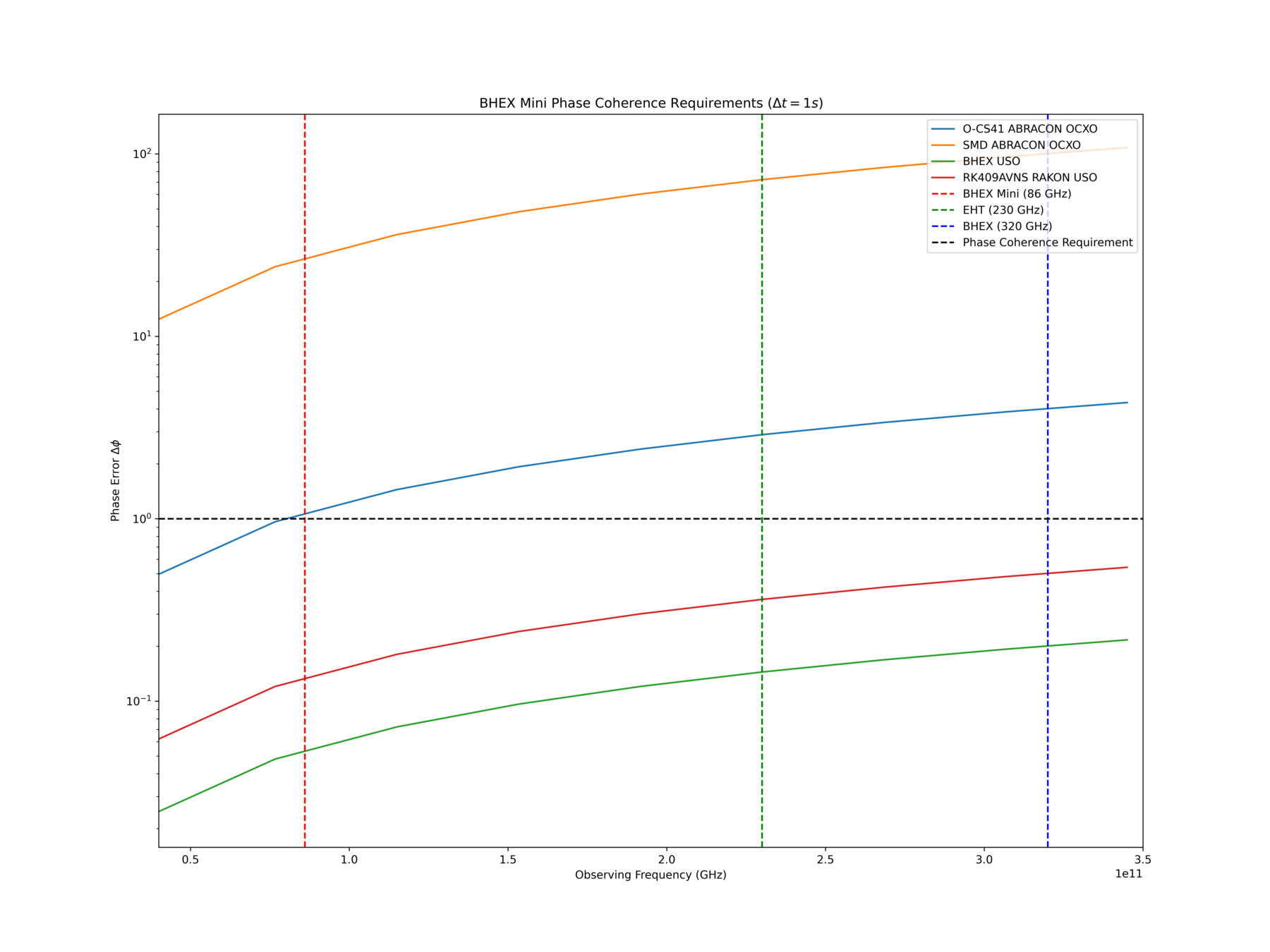
Phy
- What are BHEX Mini's primary science objectives?
- To what extent can BHEX Mini achieve its objectives?

Eng
- SWaPC Requirements for Instrumentation
Fund
- Write Grant Proposals for Nelson Grants
- Write Abstract for SpaceCom 2026
- Write De-scoped BHEX Mini #1 & #2




Coherence Loss for BHEX Mini
Coherence Loss
Coherence Loss for BHEX Mini
Observing Frequency
Coherence Loss for BHEX Mini
Integration Time
Allan Deviation
Coherence Loss for BHEX Mini
Allan Deviation

ABRACON SMD OCXO
Coherence Loss for BHEX Mini
Allan Deviation

ABRACON SMD OCXO
Coherence Loss for BHEX Mini
Allan Deviation

ABRACON SMD OCXO
Phy
- What are BHEX Mini's primary science objectives?
- To what extent can BHEX Mini achieve its objectives?

Eng
- SWaPC Requirements for Instrumentation
Fund
- Write Grant Proposals for Nelson Grants
- Write Abstract for SpaceCom 2026
- Write De-scoped BHEX Mini #1 & #2





-
Plot of Power v. Mass for selected USOs
- This will determine SWaPC requirements
- Plot of Visibility SNR for USOs/OCXOs
Phy
- What are BHEX Mini's primary science objectives?
- To what extent can BHEX Mini achieve its objectives?

Eng
- SWaPC Requirements for Instrumentation
Fund
- Write Grant Proposals for Nelson Grants
- Write Abstract for SpaceCom 2026
- Write De-scoped BHEX Mini #1 & #2




Phy
- What are BHEX Mini's primary science objectives?
- To what extent can BHEX Mini achieve its objectives?

Eng
- SWaPC Requirements for Instrumentation
Fund
- Write Grant Proposals for Nelson Grants
- Write Abstract for SpaceCom 2026
- Write De-scoped BHEX Mini #1 & #2



BHEX Mini Next Steps

Phy
- What are BHEX Mini's primary science objectives?
- To what extent can BHEX Mini achieve its objectives?


BHEX Mini Science Objectives (Safety)
- Supplement (u,v) coverage of Sgr A*/M87 at 86 GHz

BHEX Mini Science Objectives (Match)
- 86 GHz VLBI survey of AGN Targets with d~2.5m antenna
- Achieve Space-Space VLBI for the first time

BHEX Mini Science Objectives (Reach)
- Enable imaging of dynamical accretion disk phenomenon
- This would enable the first constraints on spin of Sgr A*
- Enable multi-messenger astronomy of binary black hole targets
- In conjunction with LIGO, LISA, or Einstein Telescope















Todd Ely
Joseph Lazio
Eric Burt
Ben Hudson
Luke Anderson
Rick Fleeter

BHEX Mini Proposal Feedback


Todd Ely

BHEX Mini Proposal Feedback


Todd Ely
TLDR: It will be tough to fit an highly accurate clock on a small satellite
BHEX Mini Proposal Feedback
TLDR: It will be tough to fit an highly accurate clock on a small satellite



Eric Burt

- 🎯 Primary Science Objectives
- 🔭 SWAPC Requirements
- 📻 Antenna Dimensions
- 🧊 Cryocooler Requirements
- 🕰️ Frequency Reference System
- 🕒 BHEX Mini Timeline
- 💰Funding Deadlines
BHEX Mini





Metrics and motivations for Earth–space VLBI: Time-resolving Sgr A* with the Event Horizon Telescope (Palumbo et. al., ApJ 2019)

BHEX Mini
BHEX Mini Orbit

Sub-milli arcsecond angular resolution:
BHEX Mini Unique Advantages
Sub-milli arcsecond angular resolution:
BHEX Mini Unique Advantages
Dual short and long baseline lengths:
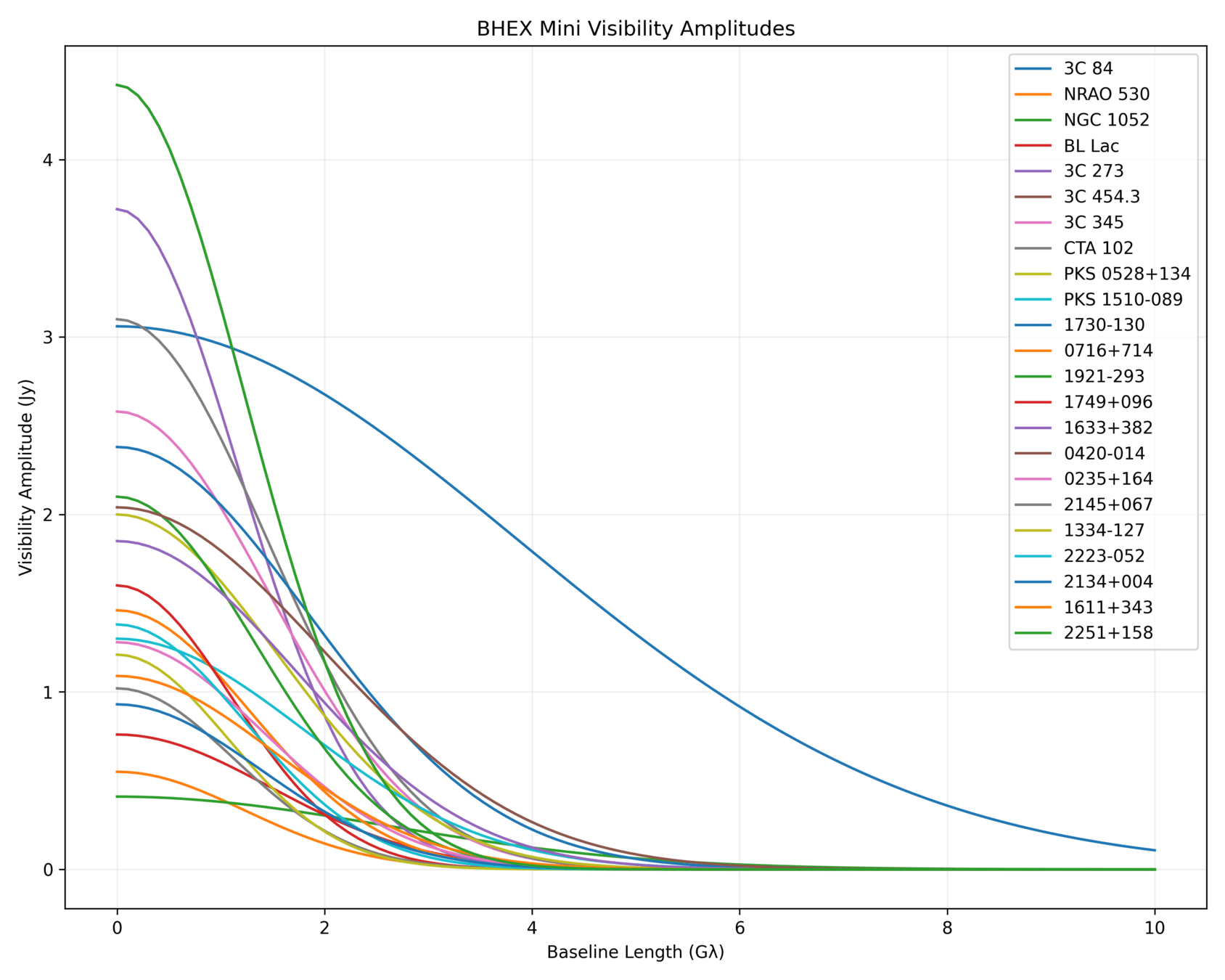
Sub-milli arcsecond angular resolution:
BHEX Mini Unique Advantages
Dual short and long baseline lengths:




Sub-milli arcsecond angular resolution:
BHEX Mini Unique Advantages
Dual short and long baseline lengths:





Sub-milli arcsecond angular resolution:
BHEX Mini Unique Advantages
Dual short and long baseline lengths:
Rapid coverage of (u,v) plane:
Michael Johnson et. al., BHEX Team, 2024
Sub-milli arcsecond angular resolution:
BHEX Mini Unique Advantages
Dual short and long baseline lengths:
Rapid coverage of (u,v) plane:

Mid-Range Science Objectives for the Event Horizon Telescope (EHT Collaboration, 2024)

Multifrequency Black Hole Imaging for the Next-generation Event Horizon Telescope (Chael et. al., 2023, ApJ)
Sub-milli arcsecond angular resolution:
BHEX Mini Unique Advantages
Dual short and long baseline lengths:
Rapid coverage of (u,v) plane:
Less power required for data downlink from LEO than MEO:



Sub-milli arcsecond angular resolution:
BHEX Mini Unique Advantages
Dual short and long baseline lengths:
Rapid coverage of (u,v) plane:
Maximum data transmission rate (in bits per second); How fast can you send data from BHEX Mini to the earth?



Sub-milli arcsecond angular resolution:
BHEX Mini Unique Advantages
Dual short and long baseline lengths:
Rapid coverage of (u,v) plane:
Power of Transmitted Signal: Strength of downlink signal in Watts (i.e., shouting louder to be heard further away!)



Sub-milli arcsecond angular resolution:
BHEX Mini Unique Advantages
Dual short and long baseline lengths:
Rapid coverage of (u,v) plane:
Transmitter Gain: How well-focused your signal is when it leaves the satellite
(i.e., shouting into a megaphone instead of into the wind)



Sub-milli arcsecond angular resolution:
BHEX Mini Unique Advantages
Dual short and long baseline lengths:
Rapid coverage of (u,v) plane:
Receiver Gain: How effectively the ground station collects and concentrates the incoming signal (i.e., ALMA's big dish listening to our incoming signal)



Sub-milli arcsecond angular resolution:
BHEX Mini Unique Advantages
Dual short and long baseline lengths:
Rapid coverage of (u,v) plane:
Antenna Efficiency: How efficient are
both the space and ground antennas?



Sub-milli arcsecond angular resolution:
BHEX Mini Unique Advantages
Dual short and long baseline lengths:
Rapid coverage of (u,v) plane:
Noise Temperature: Background noise
of (similar to thermal noise) of receiver; Lower T means higher SNR.



Sub-milli arcsecond angular resolution:
BHEX Mini Unique Advantages
Dual short and long baseline lengths:
Rapid coverage of (u,v) plane:
Bandwidth: How "wide" the signal is in frequency space. A high frequency bandwidth is good (except possibly for thermal noise*!)



Sub-milli arcsecond angular resolution:
BHEX Mini Unique Advantages
Dual short and long baseline lengths:
Rapid coverage of (u,v) plane:
Bits per photon: How many bits each photon is encoded by (i.e., 1 bit or 2 bit)



Sub-milli arcsecond angular resolution:
BHEX Mini Unique Advantages
Dual short and long baseline lengths:
Rapid coverage of (u,v) plane:
Received Power: How strong is the signal once it hits the ground receiver? (after traveling through empty space)



Sub-milli arcsecond angular resolution:
BHEX Mini Unique Advantages
Dual short and long baseline lengths:
Rapid coverage of (u,v) plane:
Distance: How much distance did the signal travel through free space? (LEO vs. MEO!)



Sub-milli arcsecond angular resolution:
BHEX Mini Unique Advantages
Dual short and long baseline lengths:
Rapid coverage of (u,v) plane:



Decreased signal loss from LEO:
Sub-milli arcsecond angular resolution:
BHEX Mini Unique Advantages
Dual short and long baseline lengths:
Rapid coverage of (u,v) plane:



Decreased signal loss from LEO:
Decreased radiation environment in LEO vs. MEO

- 🎯 Primary Science Objectives
- 🔭 SWAPC Requirements
- 📻 Antenna Dimensions
- 🧊 Cryocooler Requirements
- 🕰️ Frequency Reference System
- 🕒 BHEX Mini Timeline
- 💰Funding Deadlines
BHEX Mini

🎯 Primary Science Objectives

Original Mission
Descoped Mission
Descope Mission #2
🎯 Primary Science Objectives
OG
- 86 GHz VLBI survey of AGN Targets with d~2.5m antenna
- Supplement (u,v) coverage of Sgr A*/M87 at 86 GHz
- Achieve first Space-Space VLBI

Descoped Mission
Descope Mission #2
🎯 Primary Science Objectives
OG
- 86 GHz VLBI survey of AGN Targets with d~2.5m antenna
- Supplement (u,v) coverage of Sgr A*/M87 at 86 GHz
- Achieve first Space-Space VLBI

DS1
- d~2m antenna cooled down to sub-25K temperatures
- No Frequency Phase Transfer from 86 to 230 GHz
- ABRACON OCXO for Frequency Reference System

Descope Mission #2
🎯 Primary Science Objectives
OG
- 86 GHz VLBI survey of AGN Targets with d~2.5m antenna
- Supplement (u,v) coverage of Sgr A*/M87 at 86 GHz
- Achieve first Space-Space VLBI

DS1
- d~2m antenna cooled down to sub-25K temperatures
- No Frequency Phase Transfer from 86 to 230 GHz
- ABRACON OCXO for Frequency Reference System

DS2

- 3 GHz VLBI survey of AGN targets
- No Space-Space VLBI with BHEX
- Ground-Space VLBI restricted to f~3 GHz ground stations

🎯 Primary Science Objectives




- 🎯 Primary Science Objectives
- 🔭 SWAPC Requirements
- 📻 Antenna Dimensions
- 🧊 Cryocooler Requirements
- 🕰️ Frequency Reference System
- 🕒 BHEX Mini Timeline
- 💰Funding Deadlines

BHEX Mini

🔭 SWAPC Requirements

Antenna
Cryocooler
Frequency Reference System

🔭 SWAPC Requirements

Antenna

- Antenna Diameter:
- Primary Receiver Temperature:
- Antenna Areal Density:
Cryocooler
Frequency Reference System

🔭 SWAPC Requirements

Antenna
RSP2
- Raytheon RSP2: Sterling-PT Hybrid (450W Input)
- Stage 1 (Sterling): 6W at 60K
- Stage 2 (Pulse Tube): 2.1W at 20K


- Antenna Diameter:
- Primary Receiver Temperature:
- Antenna Areal Density:
Frequency Reference System

🔭 SWAPC Requirements

Antenna
RSP2
- Raytheon RSP2: Sterling-PT Hybrid (450W Input)
- Stage 1 (Sterling): 6W at 60K
- Stage 2 (Pulse Tube): 2.1W at 20K
USO
- LISA USO:
- RK409 Rakon USO:
- O-CS41 ABRACON OCXO:



- Antenna Diameter:
- Primary Receiver Temperature:
- Antenna Areal Density:

🔭 SWAPC Requirements

Antenna
RSP2
- Raytheon RSP2: Sterling-PT Hybrid
- Stage 1 (Sterling): 6W at 60K
- Stage 2 (Pulse Tube): 2.1W at 20K
USO
- LISA USO:
- RK409 Rakon USO:
- O-CS41 ABRACON OCXO:



- Antenna Diameter:
- Primary Receiver Temperature:
- Antenna Areal Density:
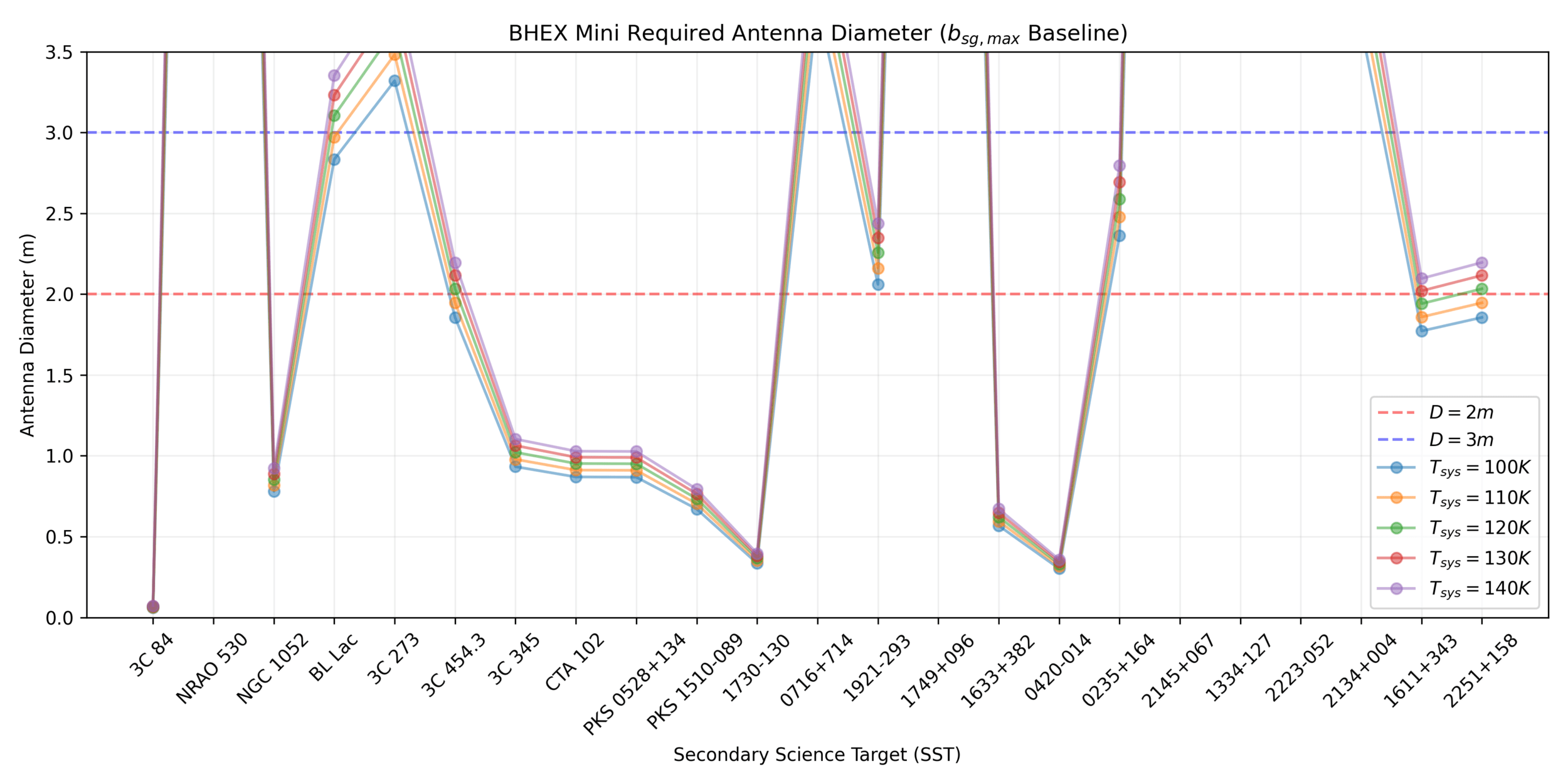



- 🎯 Primary Science Objectives
- 🔭 SWAPC Requirements
- 📻 Antenna Dimensions
- 🧊 Cryocooler Requirements
- 🕰️ Frequency Reference System
- 🕒 BHEX Mini Timeline
- 💰Funding Deadlines

BHEX Mini


📻 Antenna Dimensions


3C 84
NRAO 530
NGC 1052
BL Lac
3C 273

📻 Antenna Dimensions

3C 84
NRAO 530
NGC 1052
BL Lac
3C 273

📻 Antenna Dimensions

3C 84: Nucleus of galaxy NGC 1275 (22 GHz)
NRAO 530
NGC 1052
BL Lac
3C 273


📻 Antenna Dimensions

3C 84
NRAO 530: Quasar 230 GHz, 20 μas (EHT)
NGC 1052
BL Lac
3C 273


📻 Antenna Dimensions

3C 84
NRAO 530
NGC 1052: Bright Elliptical Galaxy (65 mln lys)
BL Lac
3C 273


📻 Antenna Dimensions

3C 84
NRAO 530
NGC 1052
BL Lac
3C 279: An 'optically violent' variable quasar

Gamma Ray Image


📻 Antenna Dimensions


3C 84
NRAO 530
NGC 1052
BL Lac
3C 273

📻 Antenna Dimensions



📻 Antenna Dimensions



📻 Antenna Dimensions



📻 Antenna Dimensions



📻 Antenna Dimensions



📻 Antenna Dimensions



- 🎯 Primary Science Objectives
- 🔭 SWAPC Requirements
- 📻 Antenna Dimensions
- 🧊 Cryocooler Requirements
- 🕰️ Frequency Reference System
- 🕒 BHEX Mini Timeline
- 💰Funding Deadlines

BHEX Mini


🧊 Cryocooler Requirements

LT-RSP2 Cryocooler

Raytheon long life cryocoolers for future space missions (T. Conrad et. al., Cryogenics 2017)

🧊 Cryocooler Requirements

Stirling Cryocooler
Development of Advanced Two-Stage Stirling Cryocooler for Next Space Missions (Y. Sato et. al., Cryocoolers 15, 2009)


🧊 Cryocooler Requirements

Stirling Cryocooler
Development of Advanced Two-Stage Stirling Cryocooler for Next Space Missions (Y. Sato et. al., Cryocoolers 15, 2009)



🧊 Cryocooler Requirements

Stirling Cryocooler
Development of Advanced Two-Stage Stirling Cryocooler for Next Space Missions (Y. Sato et. al., Cryocoolers 15, 2009)






Phase Coherence for BHEX Mini

Phase Coherence for BHEX Mini

Phase Error

Phase Coherence for BHEX Mini

Observing Frequency
Phase Coherence for BHEX Mini

Timing Jitter
Phase Coherence for BHEX Mini

Allan Deviation
Phase Coherence for BHEX Mini
Integration Time

Phase Coherence for BHEX Mini
Integration Time

Phase Coherence for BHEX Mini


Phase Coherence for BHEX Mini


Phase Coherence for BHEX Mini


Phase Coherence for BHEX Mini

Coherence Loss for BHEX Mini
Coherence Loss
Coherence Loss for BHEX Mini
Observing Frequency
Coherence Loss for BHEX Mini
Integration Time
Allan Deviation
Coherence Loss for BHEX Mini
Allan Deviation

ABRACON SMD OCXO
Coherence Loss for BHEX Mini
Allan Deviation

ABRACON SMD OCXO
Coherence Loss for BHEX Mini
Allan Deviation

ABRACON SMD OCXO
Antenna Diameter for BHEX Mini










🕒 Prospective Timeline

June
July
August
September

🕒 Prospective Timeline

June
July
August
September

- NASA NIAC 2025 Phase I Step I
- SpaceCom Conference 2026
- Brown Nelson + Hazeltine Grants
-
Antenna Focus
- Nacer Chahat
- Emmanuel Decrossas

🕒 Prospective Timeline

June
July
August
September

-
Cryocooler Focus
- Lucas Anderson
- Katelyn Boushon

- NSF Foundational Research in Robotics Grant (FRR)
- Fall Walls Foundation Selections
- NASA NIAC 2025 Phase I Step I
- SpaceCom Conference 2026
- Brown Nelson + Hazeltine Grants
-
Antenna Focus
- Nacer Chahat
- Emmanuel Decrossas

🕒 Prospective Timeline

June
July
Aug
September

-
Cryocooler Focus
- Lucas Anderson
- Katelyn Boushon

- NSF Foundational Research in Robotics Grant (FRR)
- Fall Walls Foundation Selections

- Brown University Co-Lab
- NASA NIAC Phase I Round I Step B Selections Announced
-
Solar Panel Focus
- DCubed Inc.
- DHV Tech
- NASA NIAC 2025 Phase I Step I
- SpaceCom Conference 2026
- Brown Nelson + Hazeltine Grants
-
Antenna Focus
- Nacer Chahat
- Emmanuel Decrossas

🕒 Prospective Timeline

June
July
Aug
Sep

-
Cryocooler Focus
- Lucas Anderson
- Katelyn Boushon

- NSF Foundational Research in Robotics Grant (FRR)
- Fall Walls Foundation Selections

- Brown University Co-Lab
- NASA NIAC Phase I Round I Step B Selections Announced
-
Solar Panel Focus
- DCubed Inc.
- DHV Tech
- NSF Advanced Technologies and Instrumentation for the Astronomical Sciences (ATI)
-
Data Downlink Focus
- MIT Lincoln Labs
- ALICE/CLICK Teams

- NASA NIAC 2025 Phase I Step I
- SpaceCom Conference 2026
- Brown Nelson + Hazeltine Grants
-
Antenna Focus
- Nacer Chahat
- Emmanuel Decrossas

🕒 Prospective Timeline











Antenna

🕒 Prospective Timeline











Cryocooler

🕒 Prospective Timeline











Solar Panels

🕒 Prospective Timeline











Orbital Parameters

🕒 Prospective Timeline











Data Downlink

🕒 Prospective Timeline











Systems Integration

- 🕒 Prospective Timeline
- 💰Funding Deadlines
- 🎯 Primary Science Objectives
- 🔭 Antenna Requirements
- 🧠 Ideas!
BHEX Mini


💰Funding Oppurtunities


June
$3,000
💰Funding Oppurtunities


July

$175,000
$3,000
$175,000
💰Funding Oppurtunities


Sep


$175,000
$3,000
$250,000
💰Funding Oppurtunities




Oct


$175,000
$3,000
$250,000
💰Funding Oppurtunities

- 🕒 Prospective Timeline
- 💰Funding Deadlines
- 🎯 Primary Science Objectives
- 🔭 Antenna Requirements
- 🧠 Ideas!
BHEX Mini


🎯 Mission Statement


🎯 Mission Statement


🎯 Mission Statement





- 🕒 Prospective Timeline
- 💰Funding Deadlines
- 🎯 Primary Science Objectives
- 🔭 Antenna Requirements
- 🧠 Ideas!
BHEX Mini







Secondary
Science Targets


Gaussian Source Approximation




Visibility Amplitudes





Thermal Noise Constraints





SEFD Constraint







Constraints



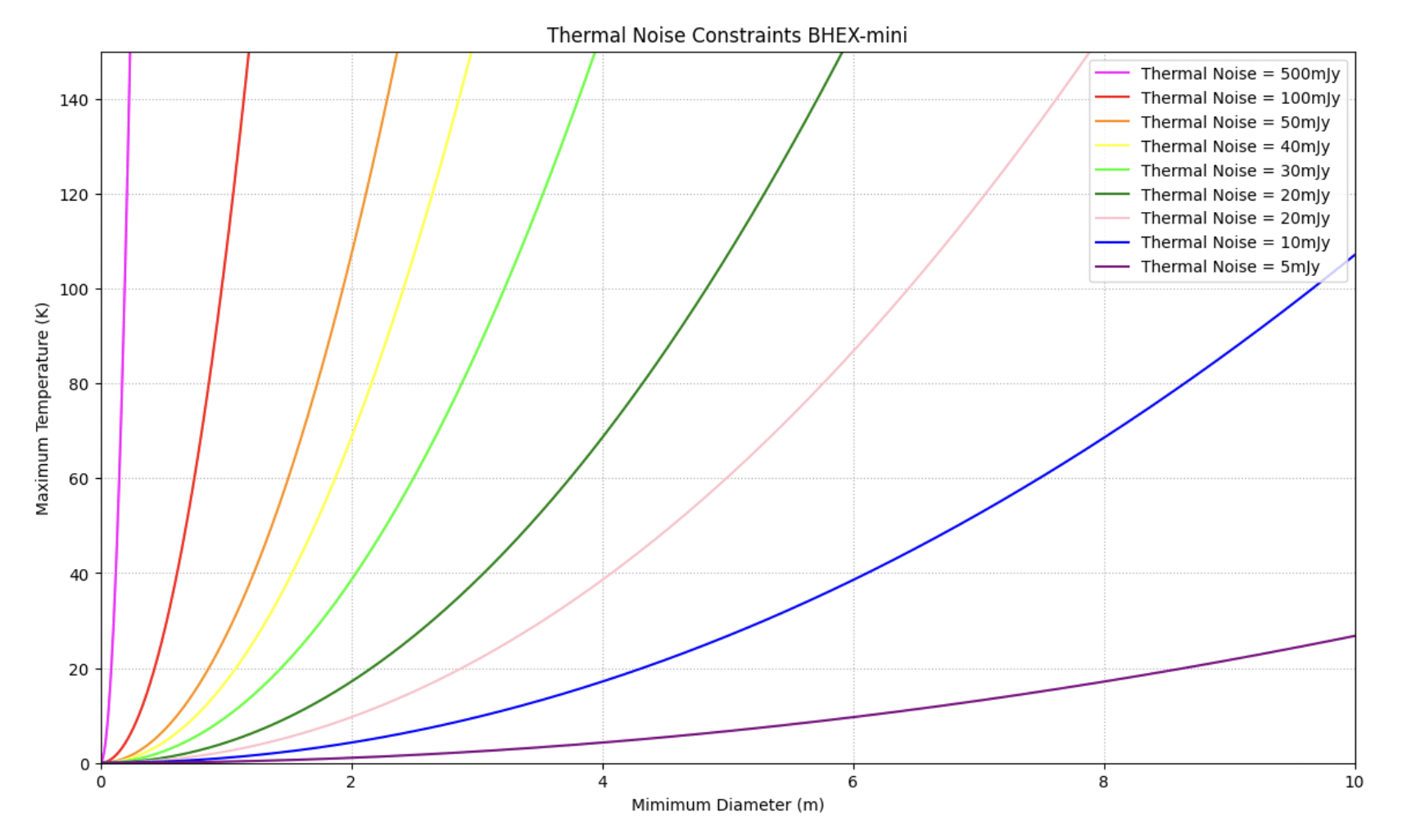
Parameter Space







Antenna Diameter + Temperature!



Visibility Amplitudes


Visibility Amplitudes




Visibility Amplitudes


Visibility Amplitudes



Visibility Amplitudes




Delta

Visibility Amplitudes




Delta

Visibility Amplitudes



Delta


Visibility Amplitudes




Delta

Visibility Amplitudes



Delta


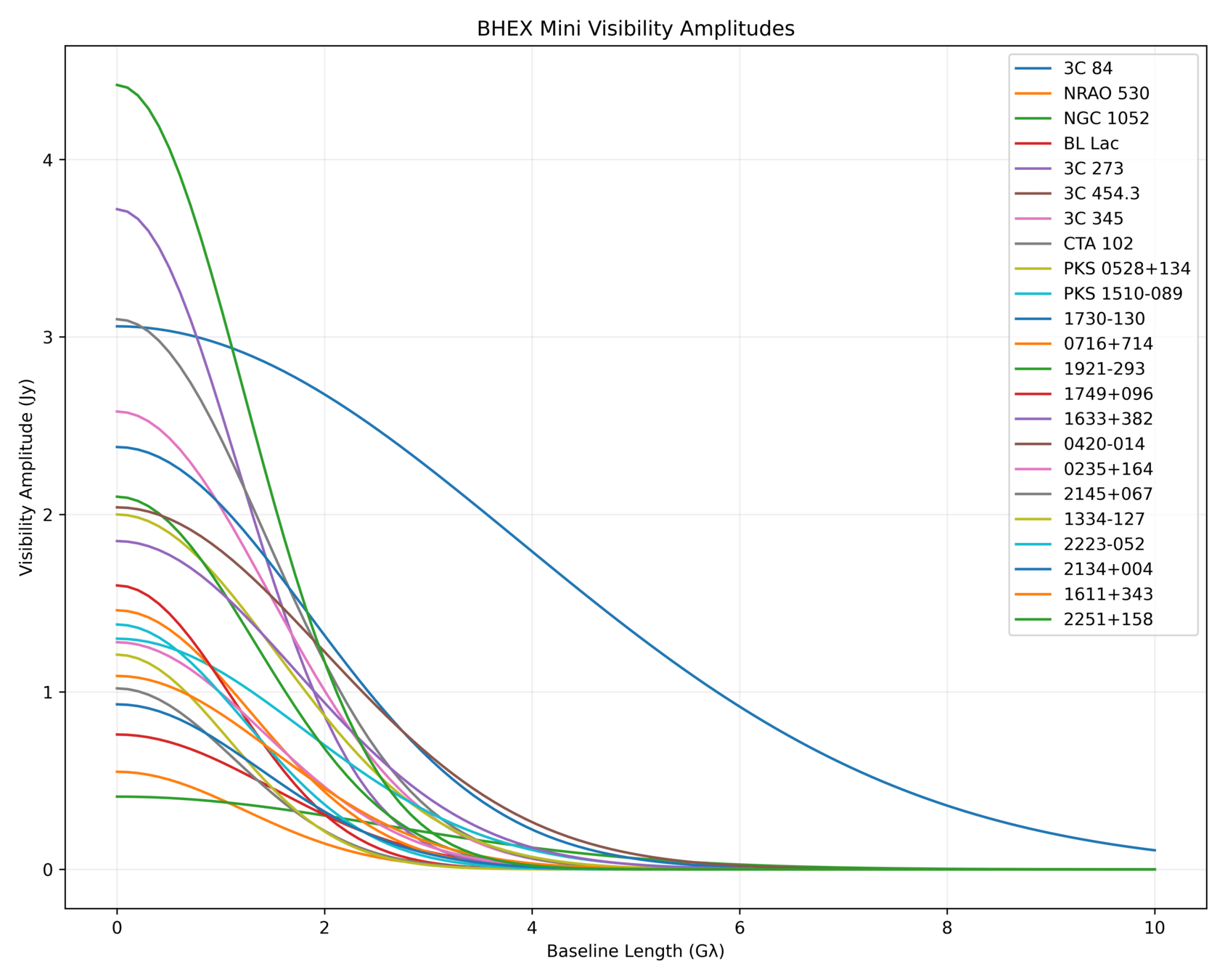
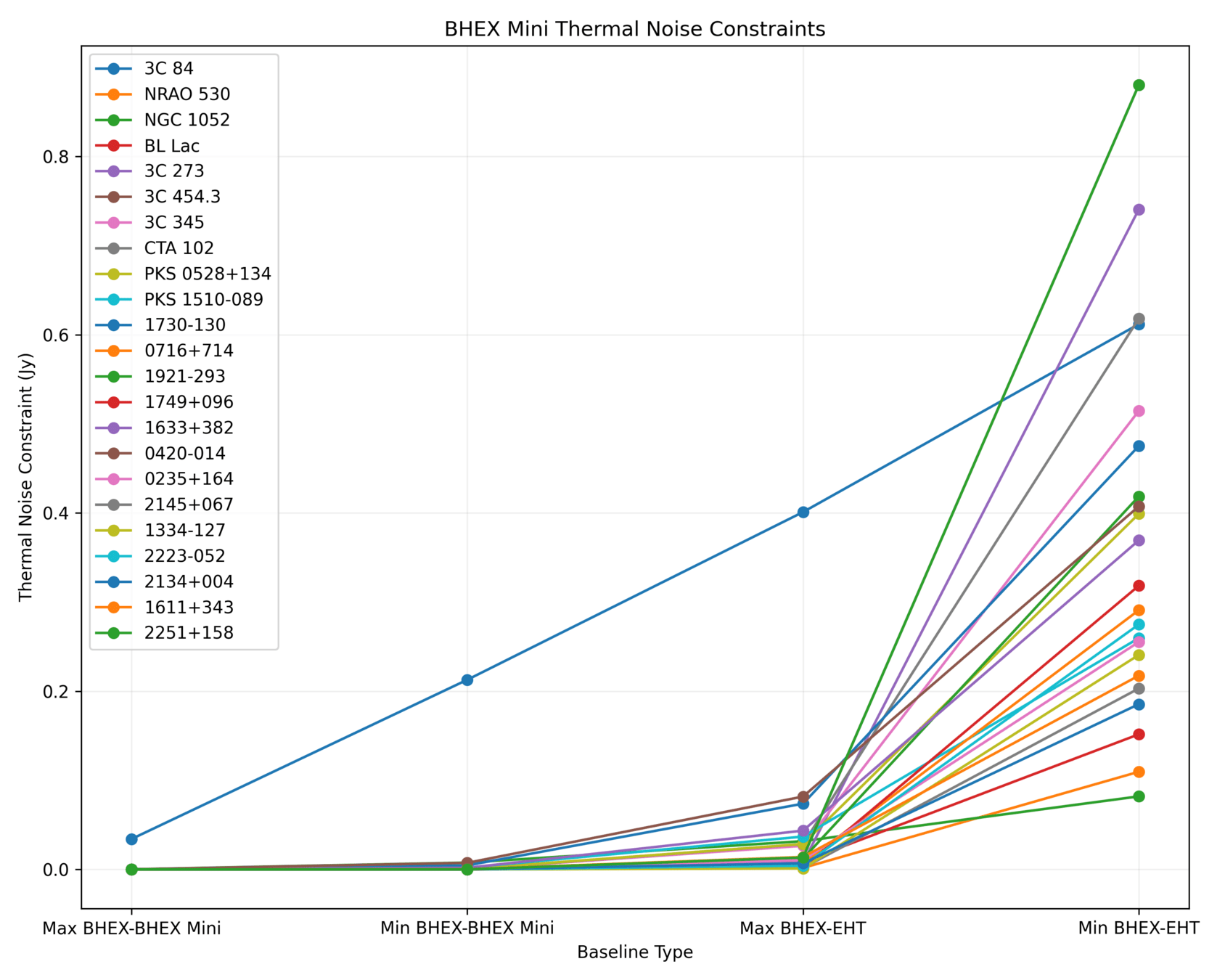
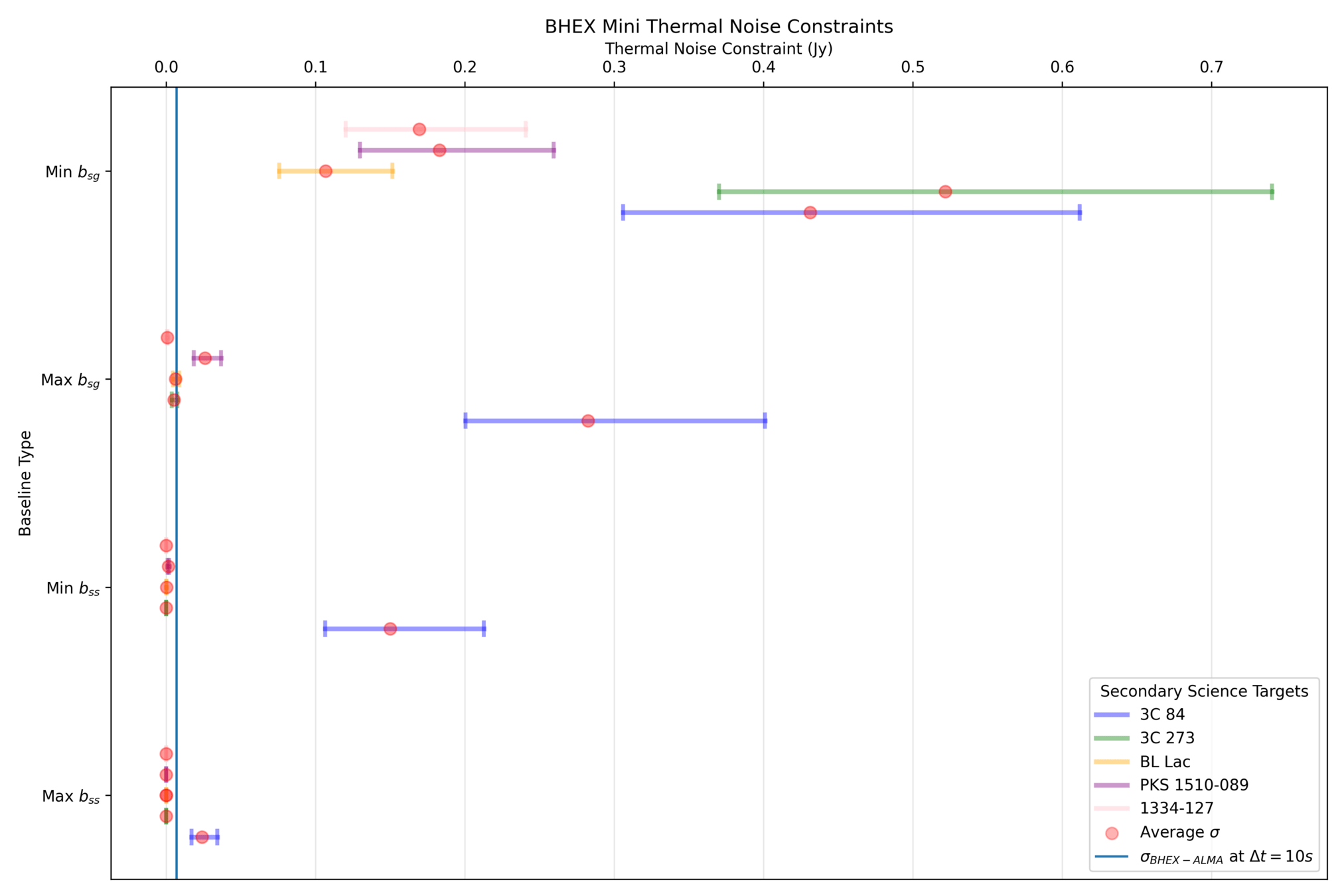
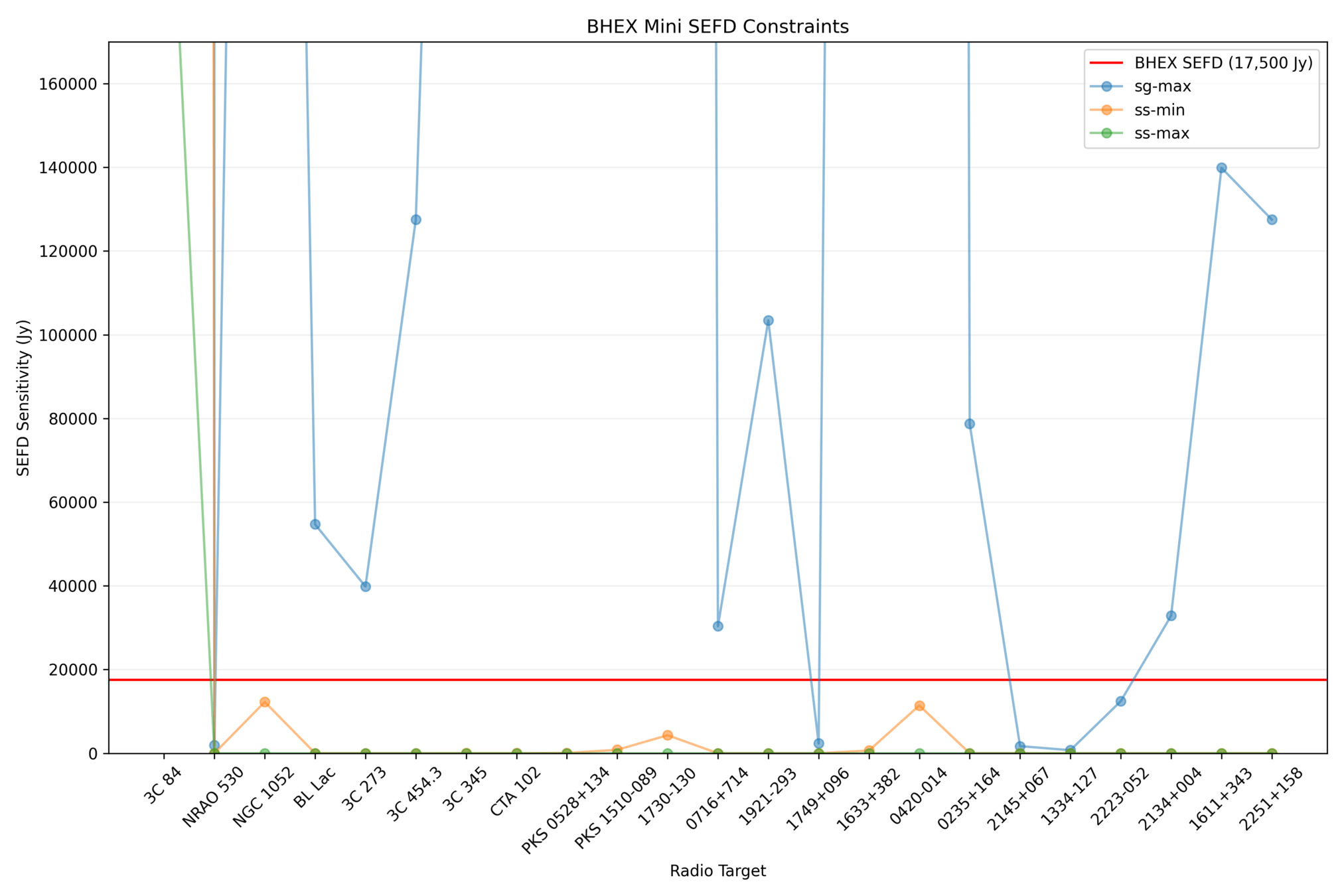
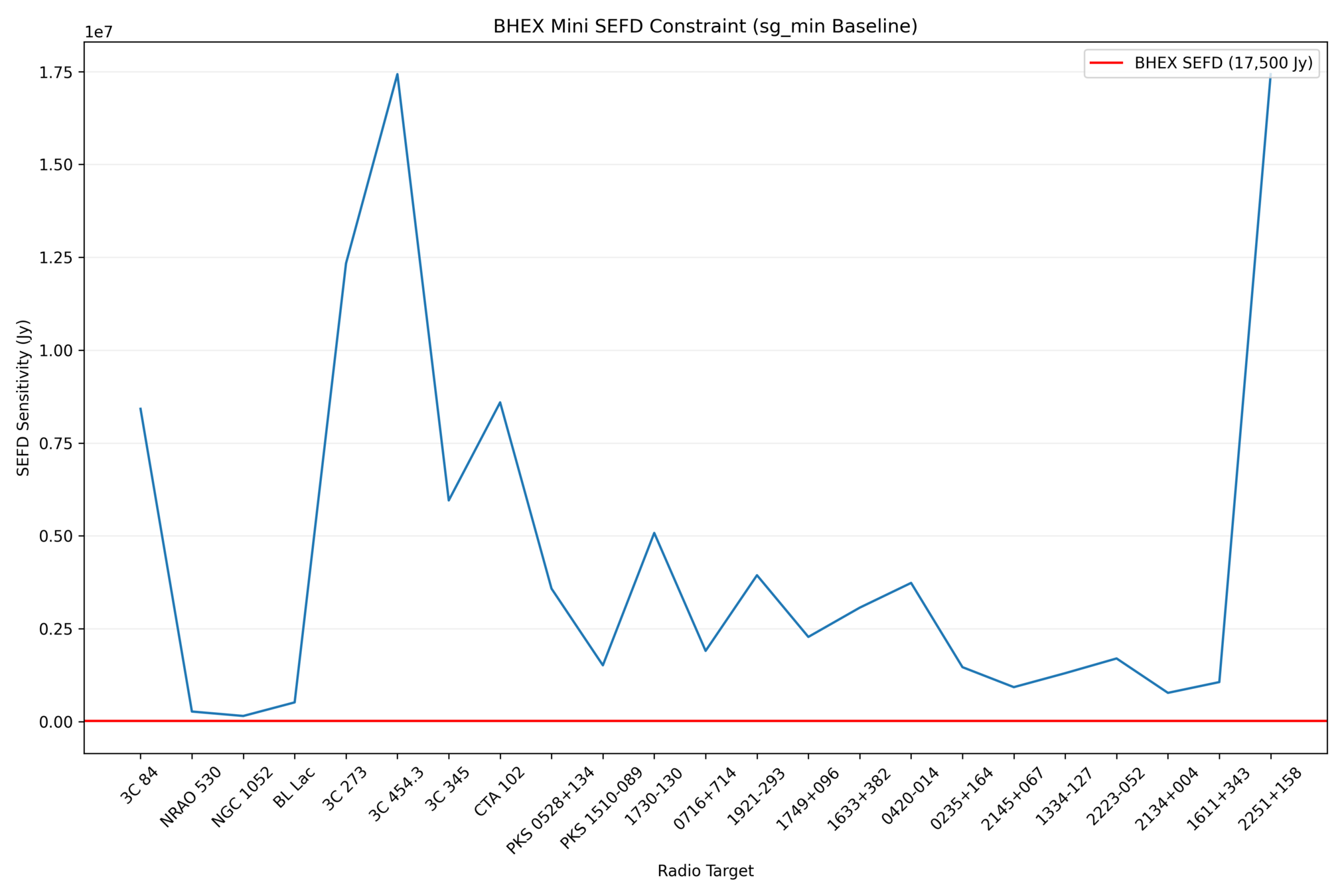
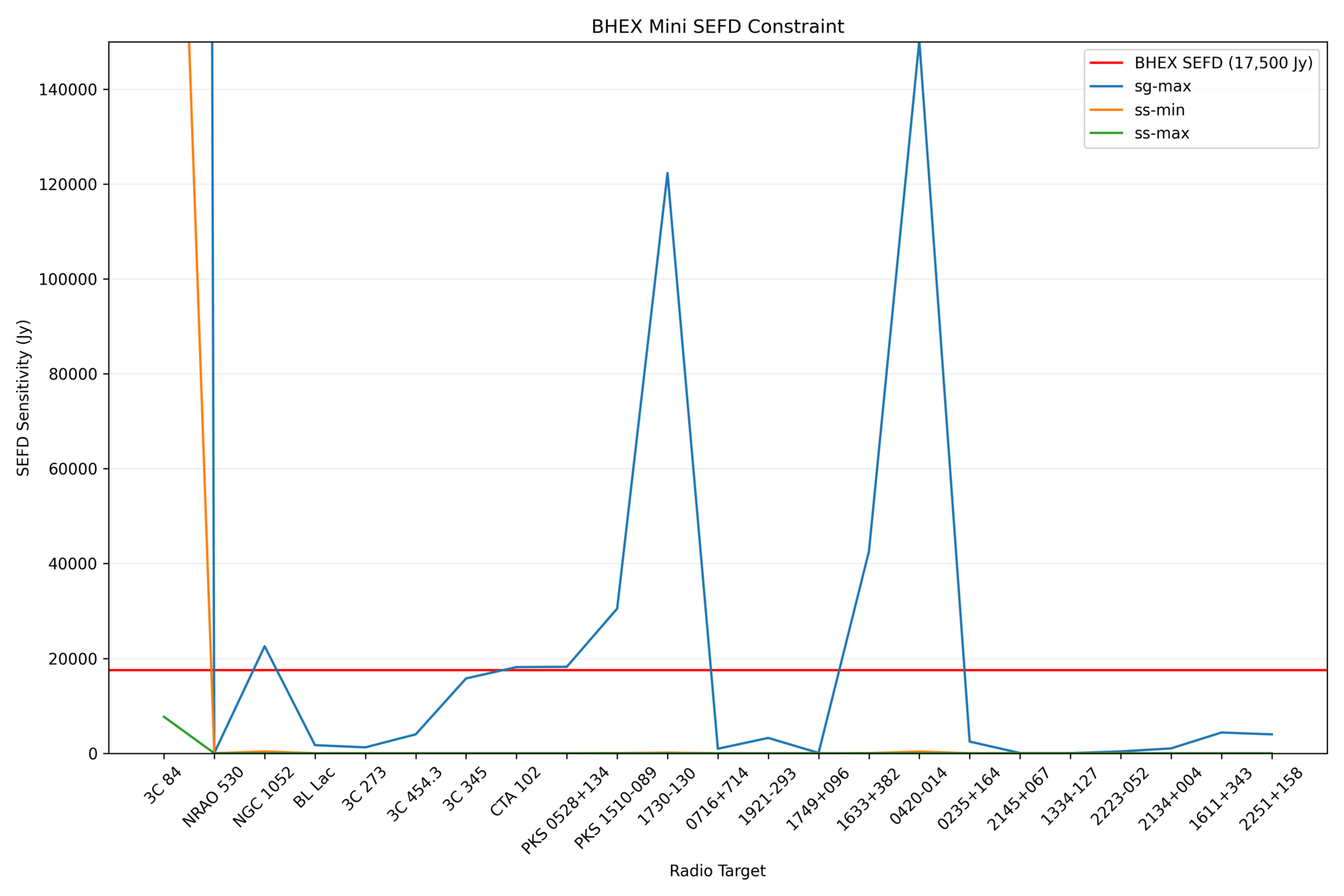
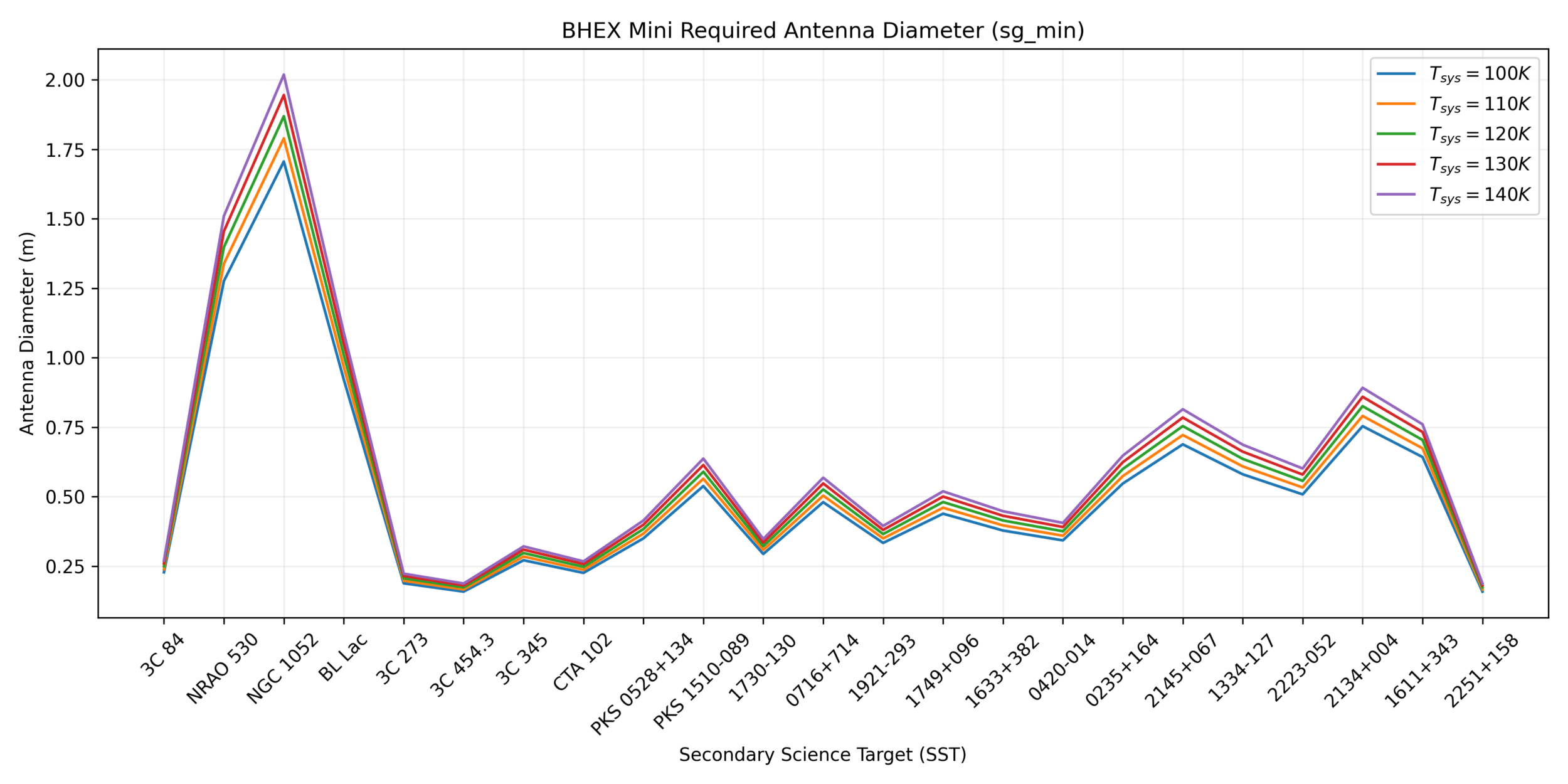

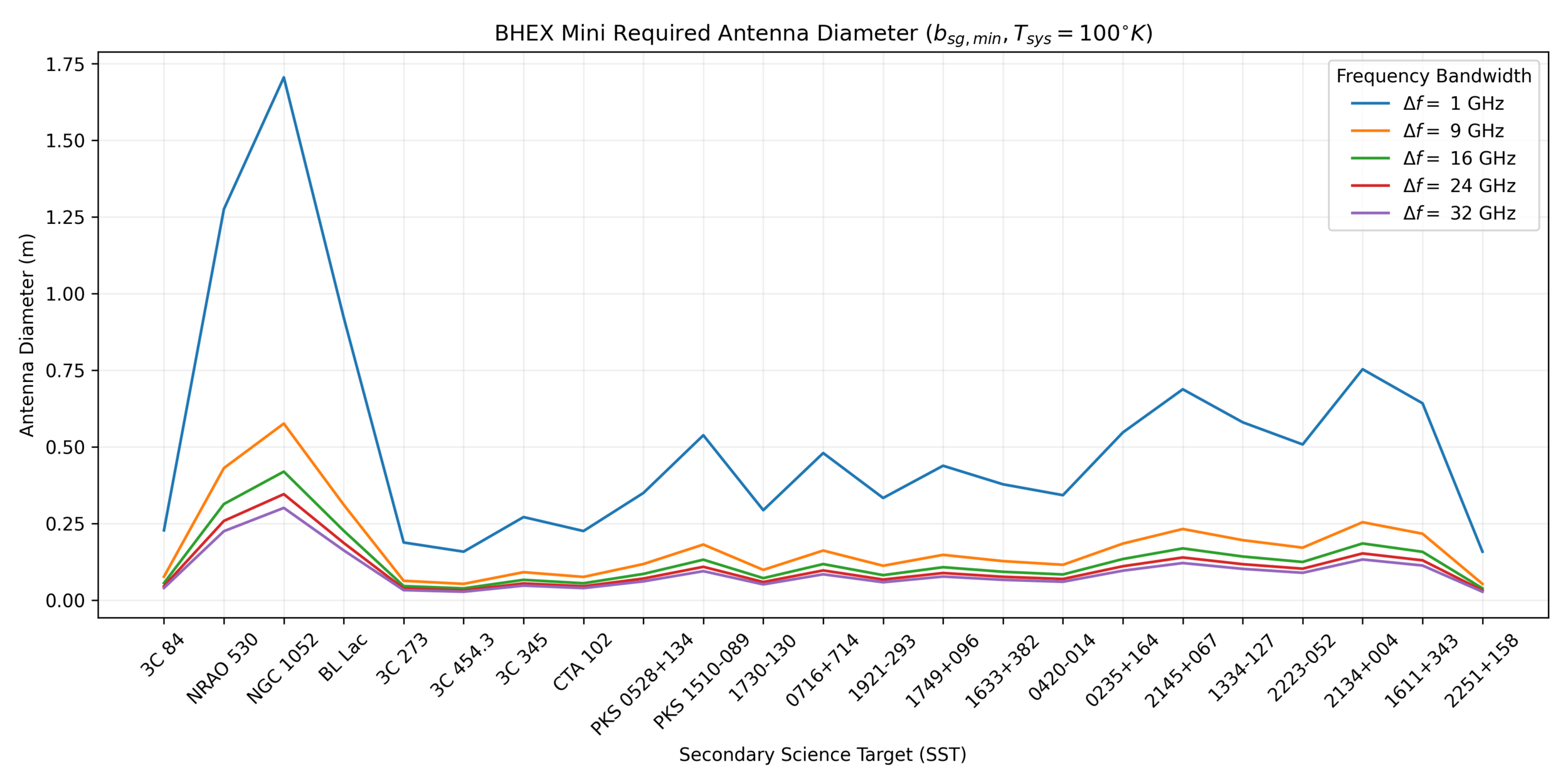









BHEX Mini

- 🕒 Prospective Timeline
- 💰Funding Deadlines
- 🎯 Primary Science Objectives
- 🔭 Antenna Requirements
- 🧠 Introduction to (u,v) Plane


🧠 The (u,v) Plane



🧠 The (u,v) Plane




🧠 The (u,v) Plane




🧠 The (u,v) Plane




🧠 The (u,v) Plane



🧠 The (u,v) Plane



🧠 The (u,v) Plane



🧠 The (u,v) Plane
Goal:


🧠 The (u,v) Plane
Intensity of a certain part of the sky/
sky brightness pattern
Goal: Measure


🧠 The (u,v) Plane
Goal: Measure
Coordinates in the sky


🧠 The (u,v) Plane
Now we add the effects of the radio interferometer ...
Coordinates in the sky


🧠 The (u,v) Plane
Now we add the effects of the radio interferometer ...
Multiplicative envelope:
comes from size of antennas


🧠 The (u,v) Plane
Now we add the effects of the radio interferometer ...
Simulates interference pattern




🧠 The (u,v) Plane
Now we add the effects of the radio interferometer ...
(u,v): Baseline vector
u: East-west baseline distance
v: North-south baseline distance




🧠 The (u,v) Plane
Take all the signals from the sky and add them up ...


🧠 The (u,v) Plane
Take all the signals from the sky and add them up ...
Visibility Function


🧠 The (u,v) Plane
Take all the signals from the sky and add them up ...
Multiplicative Envelope



🧠 The (u,v) Plane
Take all the signals from the sky and add them up ...
Sky Intensity/Brightness



🧠 The (u,v) Plane
Take all the signals from the sky and add them up ...
Interferometric Pattern




🧠 The (u,v) Plane
It's a Fourier Transformation!
One pair of antennas measures one single point on the (u,v) plane: one fourier mode!


🧠 The (u,v) Plane
It's a Fourier Transformation!
What we want



🧠 The (u,v) Plane
It's a Fourier Transformation!
What we get :(



🧠 The (u,v) Plane
It's a Fourier Transformation!
Fill up the (u,v) plane
and then fourier transform back to the real image!



🧠 The (u,v) Plane
It's a Fourier Transformation!
Fill up the (u,v) plane
and then fourier transform back to the real image!



🧠 The (u,v) Plane
But how do you fill up the (u,v) plane?



🧠 The (u,v) Plane
But how do you fill up the (u,v) plane?
- Use an array of antennas!






🧠 The (u,v) Plane
- Use an array of antennas!






🧠 The (u,v) Plane
- Use an array of antennas!






🧠 The (u,v) Plane
But how do you fill up the (u,v) plane?
- Use an array of antennas!
2. Earth Rotation Aperture Synthesis







🧠 The (u,v) Plane
2. Earth Rotation Aperture Synthesis





